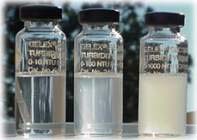Cloudiness
The opacity , also known as turbidity ( Latin: turbidus , turbid), of a transparent solid , a liquid or a gas is a subjective visual impression. It is caused by small particles that have a different refractive index than the carrier material or that cause absorption .
Historical
In the past, the turbidity of a liquid was measured with a transparent container, on the back of which was a viewing panel (similar to the eye test at an ophthalmologist), which was viewed through the liquid. The number that was just legible corresponded to the measured turbidity. However, this procedure was very imprecise and also dependent on the subjective perception of the test person.
Measurement in liquids
Measurement method
Nowadays the turbidity of a liquid is still determined optically, but measured by means of electronic evaluation. The wavelength of the measurement radiation is usually in the infrared range at 860 nm (according to ISO 7027).
As a rule, a distinction is made between two measurement methods:
- The weakening of the transmitted light radiation (transmitted light), best suited for the detection of larger opacities.
- The lateral scattering of the light radiation ( scattered light ), best suited for the detection of small cloudiness.
units
In order to be able to measure turbidity in a comparable way, the turbidity standard liquid formazin was created. All turbidity units relate to dilutions of this liquid.
The most common turbidity units are:
- FAU Formazine Attenuation Units - transmitted light measurement (angle 0 °) according to the regulations of the ISO 7027 standard
- FNU Formazine Nephelometric Units - Scattered light measurement (angle 90 °) according to the regulations of the ISO 7027 standard
- FTU formazines Turbidity Unit - in the water treatment unit used
- NTU Nephelometric Turbidity Unit - Measurement at 90 ° according to US regulations, identical to FTU
- TE / F Turbidity Unit / Formazin - German unit used in water treatment
- EBC turbidity unit in the European / international unit - brewing for beers is used
Only for formazin applies: FAU = FNU = FTU = NTU = TE / F.
All other liquids deliver different values at the different measuring angles. For example, milk whose fat droplets have a particle size similar to that of formazin (approx. 1 µm) produces a difference of up to 50% with 0 ° transmitted light measurement and 90 ° scattered light measurement.
Typical values
| medium | Turbidity value (NTU) |
|---|---|
| Cleanest water | 0.016 |
| Drinking water (measured in the waterworks) | 0.05-0.5 |
| Drinking water (measured in the household) | 1-5 |
| sewage | 100-2,000 |
| Sewage treatment plant drain | 0.5-10 |
| Formazin | 4,000 |
| Milk (1.5% fat) | <60,000 |
| Milk (3.5% fat) | > 100,000 |
Turbidity values below 0.016 cannot be measured optically, since the pure water molecules already have an influence on the light radiation.
Turbidity in gases
See u. a. Investigation of the engine management and emission control system .
The turbidity of exhaust gases is often given as the turbidity value or extinction coefficient or smoke density in m −1 or in HSU ( Hartridge Smoke Units , without a unit or as a percentage).
The extinction of the light of a certain wavelength is determined based on the measured transmittance (ratio of light passing through to radiated light) over a measuring length:
For a given wavelength, the extinction is proportional to the smoke density and the measuring length :
The exhaust gas opacity in Hartridge Smoke Units is the opacity as a percentage based on a measuring chamber length of 430 mm at atmospheric pressure and 100 ° C:
Measurements are made with green light (520 nm).
See also
Individual evidence
- ↑ warensortiment.de: Turbidity meters / turbidity meters
- ↑ metrisa.de: Turbidity measurement according to DIN EN 27027 (ISO 7027), EBC, MEBAK, ASBC, EPA, IOB ( Memento of the original from May 17, 2015 in the Internet Archive ) Info: The archive link was automatically inserted and not yet checked. Please check the original and archive link according to the instructions and then remove this notice.
- ↑ United States Patent 4066364: Apparatus for measuring smoke density
- ↑ Indus Scientific: Smoke Meter OMS 101 ( Memento from August 15, 2009 in the Internet Archive )










